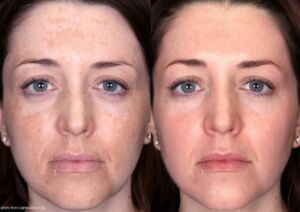Laser/light Therapy for Sun-damaged Skin : Laser/light therapy is a non-toxic and non-invasive therapy that uses light energy to repair and regenerate skin cells. The procedure reduces the need for medication, improves the outcomes for treated skin conditions and increases the recovery rates of affected tissues.
Why choose Laser/Light Therapy for Sun-damaged Skin?
Benefits of laser/light therapy include:
- Less need for pain medication following treatment.
- Increased energy for cells in the treatment area.
- Improved immune response.
- Improved healing response.
- Promotion of collagen for new skin production.
- Better lymphatic drainage, leading to reduced swelling.
- Improved blood circulation in treatment area.
- Reduced inflammation.
Possible risks:
As with any treatment, there are risks associated with it, though they are minimized in the hands of a qualified ASDS dermatologist. These include:
- Pain
- Swelling
- Discoloration
- Bleeding
- Infection
- Scarring
- Crusting
What you should know about laser/light therapy for sun-damaged skin:
During laser/light therapy, a low-level laser, usually red, is applied to the area of sun-damaged skin. The laser transmits photons about three inches into the skin. Mitochondria in the skin membranes absorb the red laser light, causing an increase of adenosine triphosphate levels, leading to an increase in healthy cell production. The process also promotes healing by increasing production of collagen, enzymes and cell growth. The increased collagen production helps prevent scar tissue from forming.
What to expect after the procedure:
Patients may not see any significant changes until several weeks after the surgery. Other post-procedure issues include:
- Treated area may be pink or red for four to eight hours after treatment.
- A slight stinging sensation, similar to a mild sunburn in the treated area. This sensation usually subsides within four to six hours. Cool packs or moist cloths may be applied to reduce the sensation.
- Mild swelling in the treatment area that usually dissipates within several days.
In addition, patients should:
- Avoid applying makeup or lotion to the treated area for either 24 hours or until all signs or redness and stinging have dissipated.
- Apply a good moisturizing lotion to the treated area twice daily for the duration of the treatments and for at least three months after final treatment.
How to prepare for the procedure:
Before the procedure, an ASDS dermatologist will usually review the patient’s medical history and conduct a physical exam. This is the time for the doctor and patient to discuss expectations, potential risks and outcomes of the procedure. Patients also should:
- Avoid sunbathing, tanning beds, waxing, chemical peels or collagen injections for two weeks prior to the procedure.
- Avoid perfumes, deodorants or any potential irritants in the treatment area before and after treatment.
- Avoid aspirin, anti-inflammatory drugs and herbal supplements due to increased risk of bleeding.
Â
FAQ
What is the best laser treatment for sun damaged skin?
Laser Treatments Laser skin resurfacing is an excellent tool for reversing the effects of sun exposure. Fraxel® is a non-invasive laser therapy that helps reverse the visible effects of aging without prolonged downtime. Fraxel treatments minimize fine lines, wrinkles, hyperpigmentation and sun spots.
Is sun damaged skin permanent?
Some sun damage is permanent, although prescription medications, nonprescription remedies and skin-resurfacing treatments may improve the skin's appearance.
What can a dermatologist do for sun damage?
Laser treatments, including Photorejuvenation, Fraxel and Q-switched, can also repair sun damaged skin. ... This is also called Photofacial, Fotofacial or IPL, and it is a non-invasive procedure that makes your face look more youthful by removing and reversing sun damage, signs of rosacea and reducing pores or acne spots.

